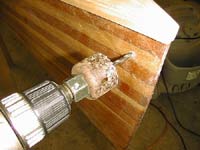 1) Best time to do the eyes is after the hull is glassed and any extra reinforcing strips have been done but before doing the final fill coats of epoxy. I typically use a 1-1/2” holesaw with the center about 1-1/2” from the bow and 1-1/4” from the stern, which in my boats is a bit wider than the bow. 1) Best time to do the eyes is after the hull is glassed and any extra reinforcing strips have been done but before doing the final fill coats of epoxy. I typically use a 1-1/2” holesaw with the center about 1-1/2” from the bow and 1-1/4” from the stern, which in my boats is a bit wider than the bow. |
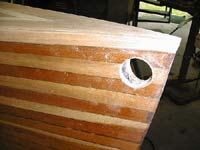 2) Drill in from each side and remove the core. 2) Drill in from each side and remove the core. |
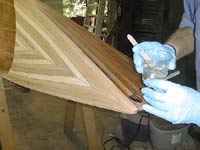 3) Turn the boat up on its side and brace in place and gather up all the materials for the next step. Mix epoxy, 3 to 4 ½ ounces. Carefully brush unthickened epoxy on the wood exposed by cutting holes. Cover the bottom hole with tape, clear packing tape will let you see what you’re doing next. 3) Turn the boat up on its side and brace in place and gather up all the materials for the next step. Mix epoxy, 3 to 4 ½ ounces. Carefully brush unthickened epoxy on the wood exposed by cutting holes. Cover the bottom hole with tape, clear packing tape will let you see what you’re doing next. |
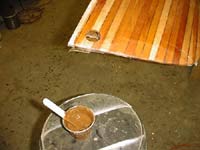 4) Add wood flour to epoxy to make a paste the consistency of slightly runny peanut butter. I normally use sanding dust from the hull so there’s some color consistency with the eye and add just enough microballons to lighten the color a bit, an all microballon eye would be lightweight but soft and would abrade heavily over time. 4) Add wood flour to epoxy to make a paste the consistency of slightly runny peanut butter. I normally use sanding dust from the hull so there’s some color consistency with the eye and add just enough microballons to lighten the color a bit, an all microballon eye would be lightweight but soft and would abrade heavily over time. |
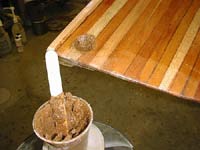 5) Spread paste around the bottom hole next to the tape and stipple a little to make sure there are no voids. Add a little Cab-o-sil to thicken the paste to stiff peanut butter consistency and finish filling the hole trying to get the paste just proud of the hull on the topside and without voids. Let cure overnight. 5) Spread paste around the bottom hole next to the tape and stipple a little to make sure there are no voids. Add a little Cab-o-sil to thicken the paste to stiff peanut butter consistency and finish filling the hole trying to get the paste just proud of the hull on the topside and without voids. Let cure overnight. |
 6) A few extra words while the epoxy paste is curing. If you have a choice of hardener speed, chose slow. Incidentally if you are using slow (System 3 silvertip in this case) do not preheat! The additional exotherm will partially melt the tape and require a little extra sanding. 6) A few extra words while the epoxy paste is curing. If you have a choice of hardener speed, chose slow. Incidentally if you are using slow (System 3 silvertip in this case) do not preheat! The additional exotherm will partially melt the tape and require a little extra sanding. |
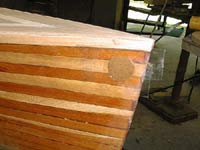 7) It is better to do the next step the next day rather than the next weekend unless you really enjoy drilling, sanding and shaping rock hard epoxy. Oh yes, if the paste has set up enough go ahead and set the boat back upright. And don’t throw away the leftover epoxy paste just yet. 7) It is better to do the next step the next day rather than the next weekend unless you really enjoy drilling, sanding and shaping rock hard epoxy. Oh yes, if the paste has set up enough go ahead and set the boat back upright. And don’t throw away the leftover epoxy paste just yet. |
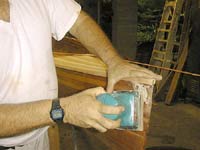 8) Remove tape. Sand epoxy plug back flush with the outer skin of boat. 8) Remove tape. Sand epoxy plug back flush with the outer skin of boat. |
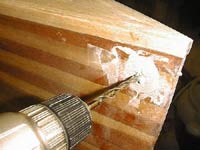 9) Drill in halfway from each side in the center of the plug and... 9) Drill in halfway from each side in the center of the plug and... |
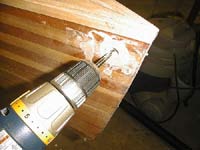 10) ...start carefully ‘wallowing’ the hole out trying to stay centered in the plug. 10) ...start carefully ‘wallowing’ the hole out trying to stay centered in the plug. |
 11) A tapered pipe reamer will make short work of opening the hole out, but I used sandpaper wrapped around a dowel to good effect for many years and boats. 11) A tapered pipe reamer will make short work of opening the hole out, but I used sandpaper wrapped around a dowel to good effect for many years and boats. |
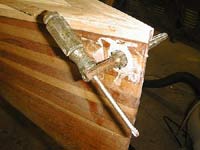 12) I like to open the hole up to where I can comfortably get a forefinger in the hole and be lose enough that I’m not concerned about getting a finger jammed and broken. Radius the edge with a strip of sandpaper (60-80 grit) shoeshine fashion. 12) I like to open the hole up to where I can comfortably get a forefinger in the hole and be lose enough that I’m not concerned about getting a finger jammed and broken. Radius the edge with a strip of sandpaper (60-80 grit) shoeshine fashion. |
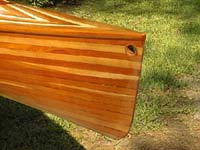 I always seem to get a few bubbles, voids or other defects so the next time I’m mixing up a little epoxy (filling deck seams in this case) I add some filler to a little bit and match the color of the first mix, that you saved, and fill in voids. I always seem to get a few bubbles, voids or other defects so the next time I’m mixing up a little epoxy (filling deck seams in this case) I add some filler to a little bit and match the color of the first mix, that you saved, and fill in voids.
Finish with the rest of the boat and you’re done, ready to paddle, assuming you’ve gota seat and foot braces. |

